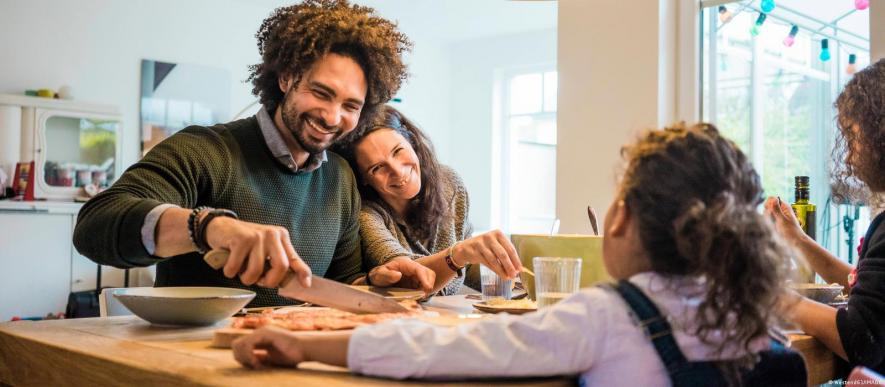Multilingualism: An Enrichment For Children's Lives

Two-and-a-half-year-old Enrique sits on the living room floor, his snub nose poking out over a picture book of colorful triangles, circles and squares. "Ou est le triangle rouge?" — "Where is the red triangle?" — his French mother Chloe Bourrat asks in French. "Ici!" replies Enrique as he taps the red triangle with his finger, beaming at his mother. "Donde esta el circulo amarillo?" — "Where is the yellow circle?" — his Spanish father Juan Koers asks in Spanish. "Aqui!" exclaims Enrique.
Like Enrique and his 8-month-old sister Alice, who live with their parents near Madrid, more and more children around the world are growing up with two or more languages at the same time.
Though the parents usually speak Spanish together, Bourrat speaks almost exclusively French with the two children, while Koers almost always speaks Spanish. Experts call this approach "one person, one language." It is one of several methods that have established themselves in multilingual education.
Yeliz Gözmez from Frankfurt has chosen a different approach with her family. She and her husband were both born in Turkey, and at home they speak Turkish with their daughters Melissa (7) and Mila (4). "Away from home — that is, at day care, at school and in their free time — the children speak German," says their mother. Experts call this method "Away from home versus at home."
![]()

The main language for the Koers-Bourrat family is SpanishImage: Privat
No perfect strategy for multilingualism
There is also the activity-based method, whereby family members might speak Arabic during mealtimes but English when playing a game. And there is also the time-based method, when children might speak Chinese in the morning while getting dressed and eating breakfast but switch to German in the evening.
Many parents wonder which method is best, but research shows that multilingual education doesn't depend on one perfect strategy. "It's more about stimulating a child with language as often and in as many different ways as possible," says Wiebke Scharff Rethfeldt, a professor at the City University of Applied Sciences in Bremen.
She says that parents should talk to children about as many different topics as possible. However, this does not mean they have to follow strict rules about which language to use but should instead choose the one they feel most comfortable with. "That can be their own native language, but it doesn't have to be," she explains.
"French and Spanish are simply the languages that feel most natural to us respectively and in which we speak to the children quite automatically," says Koers. "Turkish is the language in which we can best express our feelings," says Göcmez.
Mixing and matching languages is OK
According to Scharff Rethfeldt, expressing feelings and providing comfort and intimacy are the vital factors. "It is not about being a language teacher, but a parent building an emotional bond with a child," she says.
She also explains that parents do not have to stick to the language they feel most comfortable with all the time. "Always separating languages reflects a monolingual, monocultural mindset. That does not match our current world," she says. Scharff Rethfeldt suggests that families be flexible and switch between languages as it suits them, thus taking the pressure off parents and retaining the fun of learning for the children.
Bourrat and Koers, who both speak both languages almost perfectly, deviate from their "one person, one language" rule when the situation requires it. "For example, when Chloe's mother is visiting from France, I also speak French," says Koers. "Or when we meet with friends in Madrid, I sometimes speak Spanish with Enrique so that everyone can understand and participate in the conversation," adds Bourrat.
![]()

The Göcmez family speaks Turkish at home and German outsideImage: Privat
Mistakes allowed
But "even mistakes are not dramatic," explains Scharff Rethfeldt. "Children are very robust language learners. They learn the correct grammar rules even if from time to time they hear incorrect sentences."
The Göcmez family has a similar approach. During DW's phone call with Yeliz Göcmez, one of her daughters asked a question in Turkish. Her mother answered her in German because she was already using that language in the interview.
"At home, we take our children to language islands every now and then," says Göcmez. "We read our daughters a book in German, for example, or listen to German children's songs, even though we speak Turkish the rest of the day."
A German word might sometimes crop up in a Turkish sentence too, she says: "In everyday life, you simply can't separate 100%." Experts now agree that mixing languages is perfectly permissible because children know which word belongs to which language. They learn to distinguish languages according to their sounds when they are still in the womb.
"That is bilingualism. Mixing languages is part of it, and that's not at all bad," says Scharff Rethfeldt. "In this way, we show a child: 'Look, I'm also multilingual, I can juggle languages and switch back and forth. That's something great and positive that sets me apart — and you, too.'"
Does bilingual education also have disadvantages? There is a persistent myth that children in a multilingual environment start speaking later — or might even develop language problems. However, this has long been disproved: "Language development disorders are congenital and not triggered by bilingualism," says Scharff Rethfeldt.
About 5 to 8% of children have such a disorder — regardless of whether they are monolingual or bilingual. The problem is that in the latter case, multilingualism is often blamed.
What is true, however, is that a child might take longer to learn to speak his or her two languages as well as a monolingual child of the same age. This is not because he or she might have slower language development, but because it takes more time for a child to receive the same input in one language.
![]()

Bilingual children have a wider perspective on the worldImage: Amelie Benoist/BSIP/picture alliance
For example, a monolingual child might speak with his or her parents for four hours a day in one language, say, German. A bilingual child might spend the same four hours speaking with their parents, but two of those will be in German and the other two in Arabic, for instance. But that child may well have learned more vocabulary overall in the same amount of time.
For many experts, multilingual education has few disadvantages and many advantages. One of these, says Göcmez, is that her children can easily communicate with their relatives. "The Turkish language is like a bridge to the grandparents," she says.
"If you're able to communicate in more than one language, you have access to different cultures and ways of life," says Scharff Rethfeldt. "As a result, you are more inclined to reflect on your own perspectives — and become a bit smarter as a result."
Another advantage is that when children already speak two languages, it is much easier for them to learn other languages. "Children who grow up bilingual already know that you can't translate expressions one-to-one," the bilingualism expert says.
Yeliz Göcmez has also noticed this, particularly with an au pair who recently moved in with the family and speaks English with the children. She says that Mila has absorbed this new language like a sponge: "She already speaks in complete sentences using 'because' and 'but,' for instance. That was really a nice surprise for us."
This article was translated from German.
Get the latest reports & analysis with people's perspective on Protests, movements & deep analytical videos, discussions of the current affairs in your Telegram app. Subscribe to NewsClick's Telegram channel & get Real-Time updates on stories, as they get published on our website.














